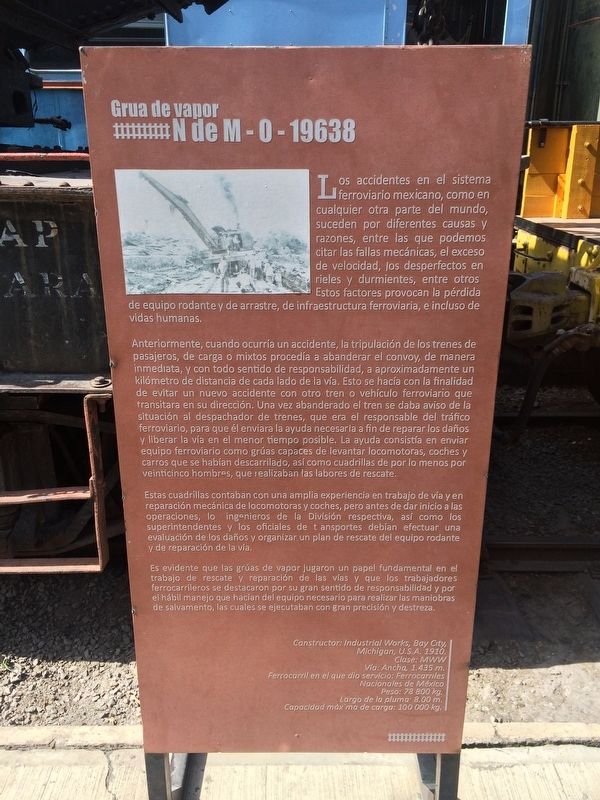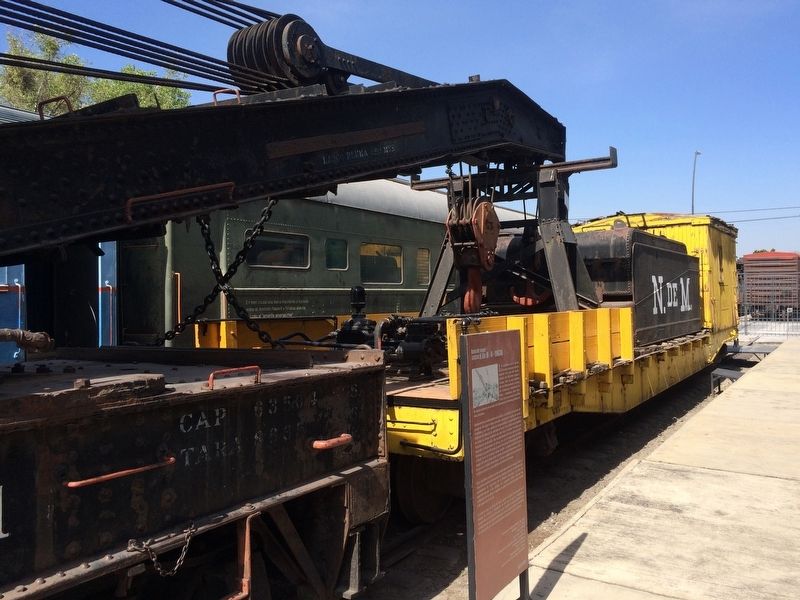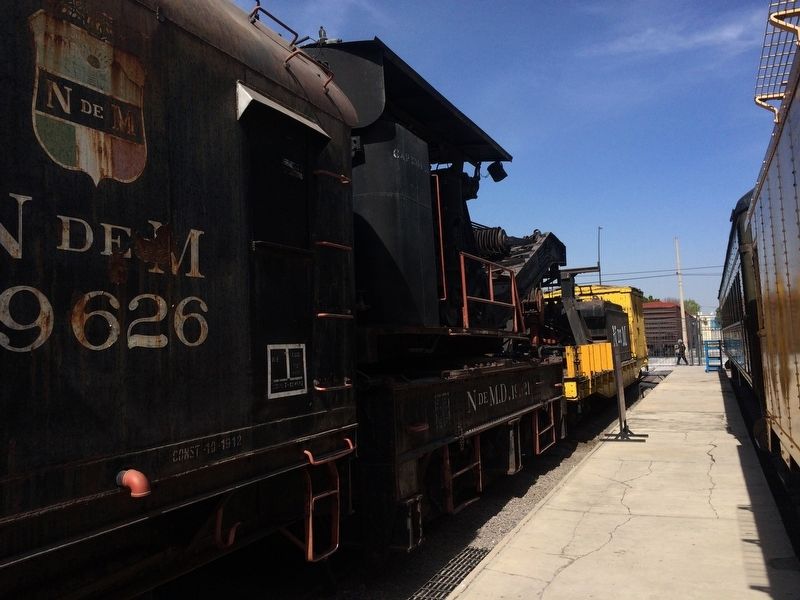Puebla, Mexico — The Central Highlands (North America)
Steam Crane NM-0-19638
Grua de vapor
N de M-0-19638
Los accidentes en el sistema ferroviario mexicano, como en cualquier otra parte del mundo, suceden por diferentes causas y razones, entre las que podemos citar las fallas mecánicas, el exceso de velocidad, los desperfectos en rieles y durmientes, entre otros. Estos factores provocan la pérdida de equipo rodante y de arrastre, de infraestructura ferroviaria, e incluso de vidas humanas.
Anteriormente, cuando ocurría un accidente, la tripulación de los trenes de pasajeros, de carga o mixtos procedía a abanderar el convoy, de manera inmediata, y con todo sentido de responsabilidad, a aproximadamente unkilómetro de distancia de cada lado de la vía. Esto se hacía con la finalidad de evitar un nuevo accidente con otro tren o vehículo ferroviario que transitara en su dirección. Una vez abanderado el tren se daba aviso de la situación al despachador de trenes, que era el responsable del tráfico ferroviario, para que él enviara la ayuda necesaria a fin de reparar los daños y liberar la vía en el menor tiempo posible. La ayuda consistía en enviar equipo ferroviario como grúas capaces de levantar locomotoras, coches y carros que se habían descarrilado, así como cuadrillas de por lo menos por veinticinco hombres, que realizaban las labores de rescate.
Estas cuadrillas contaban con una amplia experiencia en trabajo de vía y en reparación mecánica de locomotoras y coches, pero antes de dar inicio a las operaciones, lo ingenieros de la División respectiva, así como los superintendentes y los oficiales de transportes debían efectuar una evaluación de los daños y organizar un plan de rescate del equipo rodante y de reparación de la vía.
Es evidente que las grúas de vapor jugaron un papel fundamental en el trabajo de rescate y reparación de las vías y que los trabajadores ferrocarrileros se destacaron por su gran sentido de responsabilidad y por el hábil manejo que hacían del equipo necesario para realizar las maniobras de salvamento, las cuales se ejecutaban con gran precisión y destreza.
Constructor: Industrial Works, Bay City, Michigan, U.S.A. 1910.
Clase: MWW
Vía: Ancha, 1.435 m.
Ferrocarril en el que dio servicio: Ferrocarriles Nacionales de México
Peso: 78,800 kg.
Largo de la pluma: 8.00 m.
Capacidad máxima de carga: 100,000 kg.
English translation:
Steam Crane NM-0-19638
Accidents in the Mexican rail system, as in any other part of the world, happen for different reasons and causes. Among those that we can cite are mechanical failures, excess of speed, imperfections in rails and sleepers, among others. These factors lead to the loss of rolling stock and towed equipment, rail infrastructure, and even human lives.
Previously, when an accident occurred, the crew of the trains of passengers, cargo or mixed trains proceeded to flag the convoy immediately, and with all sense of responsibility, approximately one kilometer away from each side of the railroad. This was done in order to avoid a new accident with another train or rail vehicle that transited in the same direction. Once the train was flagged, the train dispatcher, who was responsible for rail traffic, was notified of the situation, so that he could send the necessary help in order to repair the damage and free the road in the shortest possible time. The help consisted in sending railway equipment, such as cranes capable of lifting locomotives and cars that had been derailed, as well as crews of at least twenty-five men, who performed the rescue work.
These crews had extensive experience in track work and mechanical repair of locomotives and cars, but before starting operations, the engineers of the respective division, as well as the superintendents and officers had to carry out an assessment of the damage and organize a rescue plan for the rolling stock and repair of the track.
It is evident that steam cranes played a fundamental role in the work of rescue and repair of the tracks and that the railroad workers stood out for their great sense of responsibility
and for the skillful handling they made of the equipment necessary to perform rescue missions, which were executed with great precision and dexterity.
Builder: Industrial Works, Bay City, Michigan, USA 1910.
Class: MWW
Track: Wide, 1.435 m
Railroad in which it served: Mexican National Railroads
Weight: 78,800 kg
Length: 8.00 m
Maximum load capacity: 100,000 kg
Topics. This historical marker is listed in these topic lists: Industry & Commerce • Roads & Vehicles. A significant historical year for this entry is 1910.
Location. 19° 3.227′ N, 98° 12.234′ W. Marker is in Puebla. Marker can be reached from Calle 11 Norte just south of Avenida 14 Poniente, on the right when traveling south. The marker is on the grounds of the Mexican National Railroad Museum, just northwest past the second row of engines and cars after the entrance and near the Steam Crane display. Touch for map. Marker is in this post office area: Puebla 72090, Mexico. Touch for directions.
Other nearby markers. At least 8 other markers are within walking distance of this marker. Passenger Car (a few steps from this marker); FT Diesel-Electric Locomotive (a few steps from this marker); Steam Engines (within shouting distance of this marker); The Railway Stations of Puebla (within shouting distance of this marker); The Hero of Nacozari (within shouting distance of this marker); Railroads in the Mexican Revolution (within shouting distance of this marker); Steam Locomotive NM-601 (within shouting distance of this marker); National Railroads of Mexico (within shouting distance of this marker). Touch for a list and map of all markers in Puebla.
Credits. This page was last revised on December 14, 2017. It was originally submitted on December 14, 2017, by J. Makali Bruton of Accra, Ghana. This page has been viewed 158 times since then and 7 times this year. Photos: 1, 2, 3. submitted on December 14, 2017, by J. Makali Bruton of Accra, Ghana.


